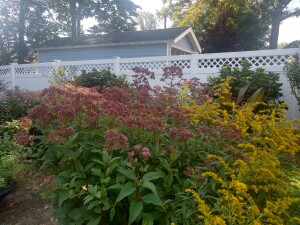 For years I have planted certain fall bloomers in my front garden in the hopes of creating a lush golden and russet display of rudbeckia, helenium, and late summer sunflowers. The current show is respectable, but would never make the pages of a glossy garden publication. I should probably just abandon the effort and cede the ground to the asters, which do what they want when they want, producing clouds of pinks, purples and blues.
For years I have planted certain fall bloomers in my front garden in the hopes of creating a lush golden and russet display of rudbeckia, helenium, and late summer sunflowers. The current show is respectable, but would never make the pages of a glossy garden publication. I should probably just abandon the effort and cede the ground to the asters, which do what they want when they want, producing clouds of pinks, purples and blues.
The lower back garden is a different story. A decade or more ago, I planted a one-gallon container of Joe Pye-weed or Eutrochium. The pollinators loved the blooms so much that by the end of the season, the plant set lots of seeds. Those sprouted the following year, producing enough Joe Pyes to start a dedicated nursery and the trend has continued ever since. To keep the situation in check, I grub out seedlings every year and give the plants several “Chelsea chops” in the spring and early summer. The latter keeps them at four feet instead of seven and results in more abundant flowers. Even with that degree of controlling behavior, I still have a large bank of Joe Pye-weed plants, which is fine because the blooming flowerheads look like puffy, purple-pink autumnal clouds.
I will admit to planting the Joe Pye-weeds and have no one to blame but myself for their wayward habits. I never planted the goldenrod that is currently cozying up to the Joe Pyes and blooming fetchingly, with golden plumes waving gently in the September breeze. It must have flown on those same breezes from the neighbor’s back forty where I have seen goldenrods in the past.
As I recall, one goldenrod—known as solidago to botanists and florists–popped up unbidden two years ago, proceeded to give birth to another couple last year, and multiplied into a full-blown clump this fall. It looks beautiful next to the Joe Pyes, providing the perfect autumnal look that I have sought in vain in the front garden.
The goldenrod/Joe Pye mix is complemented by numerous self-sown boneset or Eupatorium perfoliatum. If the name sounds unfamiliar, you probably know the lanky plants topped by flowerheads of tiny white blooms that appear somewhat fuzzy. They are another prolific species, omnipresent in untended spaces at this time of year. Long used medicinally for both internal and external ailments, boneset also makes great filler in bouquets. At this time of year I use a lot of it, if only to keep the plants from setting seed and endowing my garden with a field of baby bonesets next year.
You might call all three species noxious invasives if they weren’t all North American native plants. Both goldenrod and Joe Pye-weed have taken Europe by storm and stand out as components of fashionable landscapes designed by proponents of the “new perennials” movement on both sides of the Atlantic. Still, the plants outcompete other garden denizens, making even the butterfly weed, its countless seeds borne aloft by little wispy parachutes, look tame by comparison.
So the whole arrangement—Joe Pye-weed, goldenrod and boneset–has made my lower back garden look lush and magnificent in fall. On a clear September day, the spread is worthy of a magazine layout. I can’t claim to have much to do with this resounding success, because other than the seedling grubbing and Chelsea chopping, I don’t contribute a lot of effort. In fact, I think the plants’ reproductive activities likely take place when I am fussing with the arrangement of the front garden.
Of course I take credit for any garden success that comes my way, whether or not I had anything to do with it. It seems only fair. I work hard in the garden, what with the constant pruning of the quince bush, disciplining the holly trees and keeping the roses-of-Sharon in check, none of which garner any accolades. When encouragement comes, I think of those unsung labors and accept the kudos gracefully.
